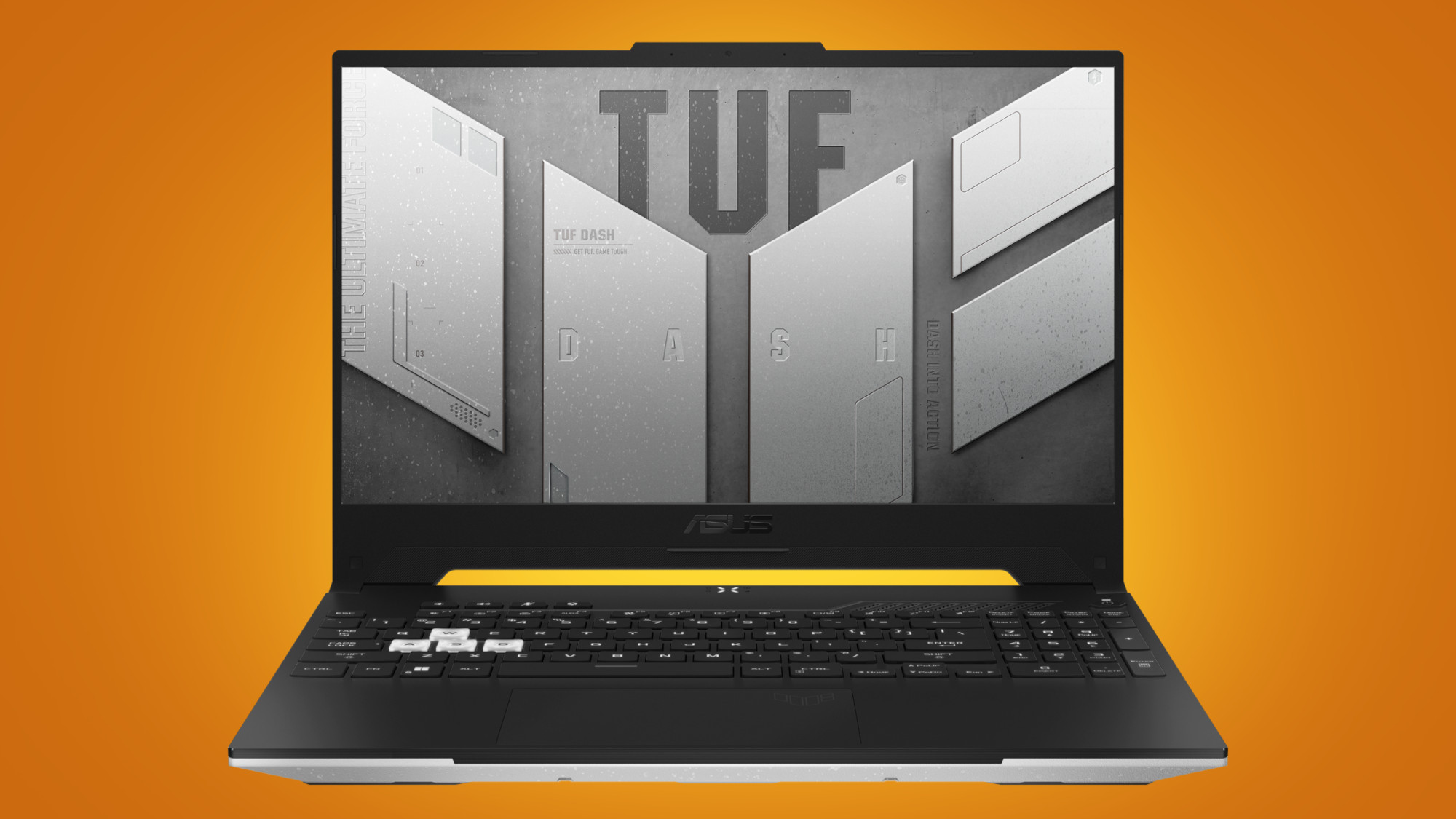TechRadar Verdict
The Asus TUF Dash F15 is a strong gaming laptop for gamers who are willing to spend a little more for that edge. The graphics card does its job and the screen looks nice, but some software issues and odd port placement hold this laptop back from true greatness.
Pros
- +
Clean, sturdy design
- +
Good performance with the RTX 3060
- +
Decent battery life
Cons
- -
Unexplained startup issues
- -
Game options are divided into two menus with the two different GPUs
- -
Ports are oddly positioned
Why you can trust TechRadar
One-minute review
Here is the Asus TUF Dash F15 configuration sent to us for review:
CPU: Intel Core i7-12650H
Graphics: GeForce RTX 3060
RAM: 16GB
Storage: 1TB SSD
Screen: 15,6" IPS panel, 144HZ, 1920 x 1080
Ports: 2x USB-A 3.2, 1x USB-C, 1x HDMI, 1x Thunderbolt 4, 1x RJ-45 Ethernet
Weight: 2 kg
Gaming laptops have long since ceased to be the clunky monsters they once were, with more and more people choosing to ditch the desktop for a laptop that you can work and game on at the same time.
Gaming laptops have always been rather expensive and you often pay a lot more for a laptop to play the same games at the same quality as you would on a regular desktop PC. The ASUS TUF Dash F15 sits in the mid-range area of the laptop market, but the graphical performance does mostly justify the price tag.
The ASUS TUF Dash F15 can run any high-quality game without any problems thanks to the Nvidia GeForce RTX 3060 and 16GB of RAM. The laptop did get a bit warm during longer gaming sessions, but there’s no need to panic. The fans do their job well enough, but we do recommend wearing a headset for prolonged use as they can get a little noisy - a foible shared by most gaming laptops, in the Dash F15's defense.
While the illuminated WASD buttons give away the fact that it’s a gaming laptop, the overall design looks sleek and doesn't scream 'gaming', so it won’t stand out too much if you wanted to take it to work.
Our review unit came in black, and unfortunately, fingerprint smudges were almost impossible to avoid on the outer casing. We also found the placement of the ports, which are all on the left side of the laptop, to be a bit odd.
Some software problems at the beginning of the test period did not leave a very strong impression, but in the final week of testing these problems did not recur. We delve more into this further down, but for now, let's get into the meat of this review.
ASUS TUF Dash F15 (2022) Price
The ASUS TUF Dash F15 is available in different configurations with the cheapest version starting from $1,289 (about £1,058 or AU$1,1918) - although if you don't mind some slightly older components, you can probably find last year's model for much cheaper.
Asus has an annoying way of naming the models, but to be clear: we tested the ASUS TUF Dash F15 (FX517ZM-HN073W). Whew, that's a mouthful. This is the midrange model; versions are also available with the Nvidia RTX 3050, 3050 Ti, and 3070.
It's a pretty steep price to pay, but you do get some decent components for your cash: an Intel Core i7-12650H, Nvidia GeForce RTX 3060, 16GB DDR5 RAM, and a large 1TB SSD. Our laptop had a 15.6-inch 144Hz IPS panel, but you can also get a version with a larger 17.3-inch screen.
Value for money: 3.5/5
ASUS TUF Dash F15 (2022) Design
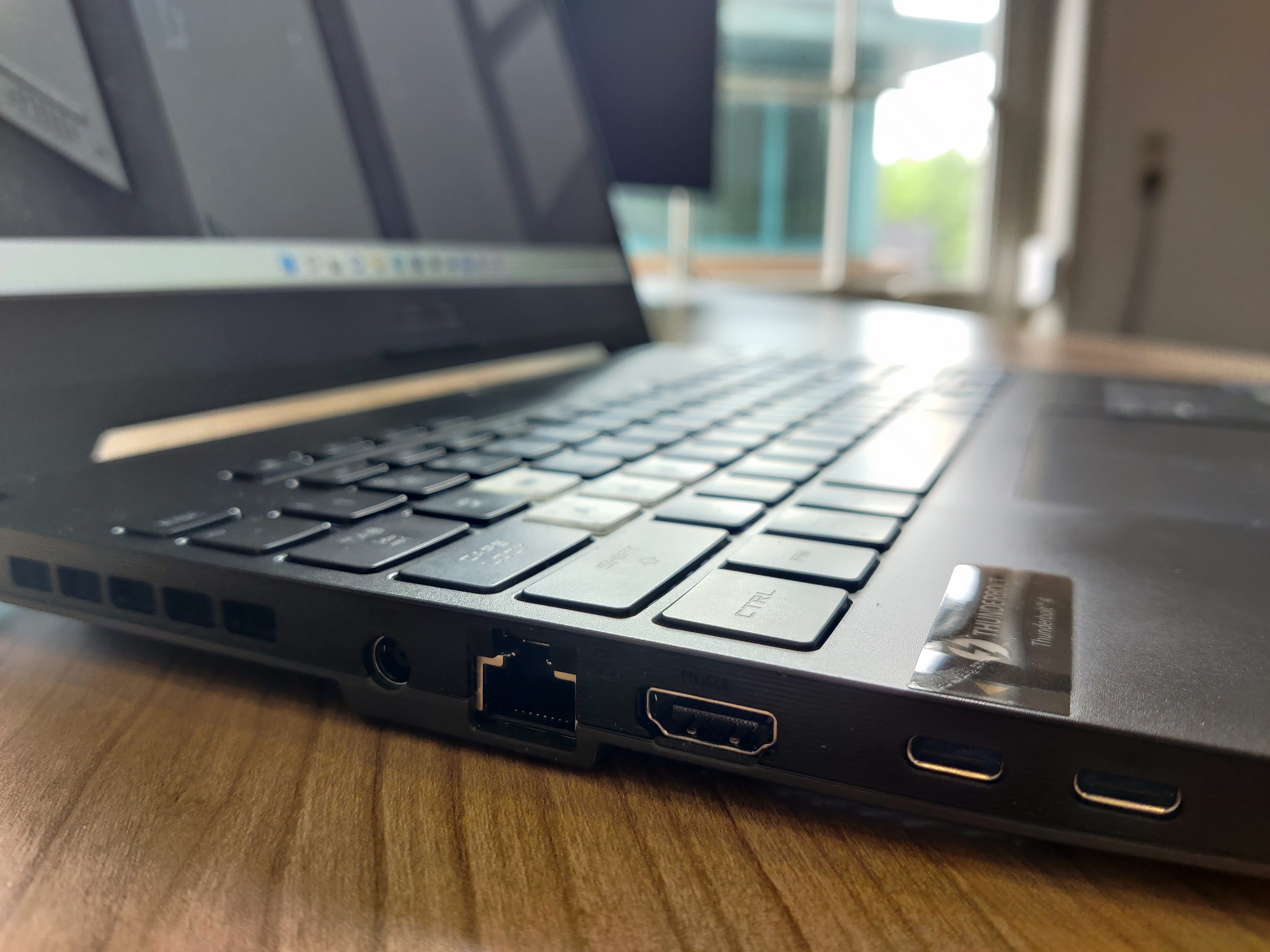
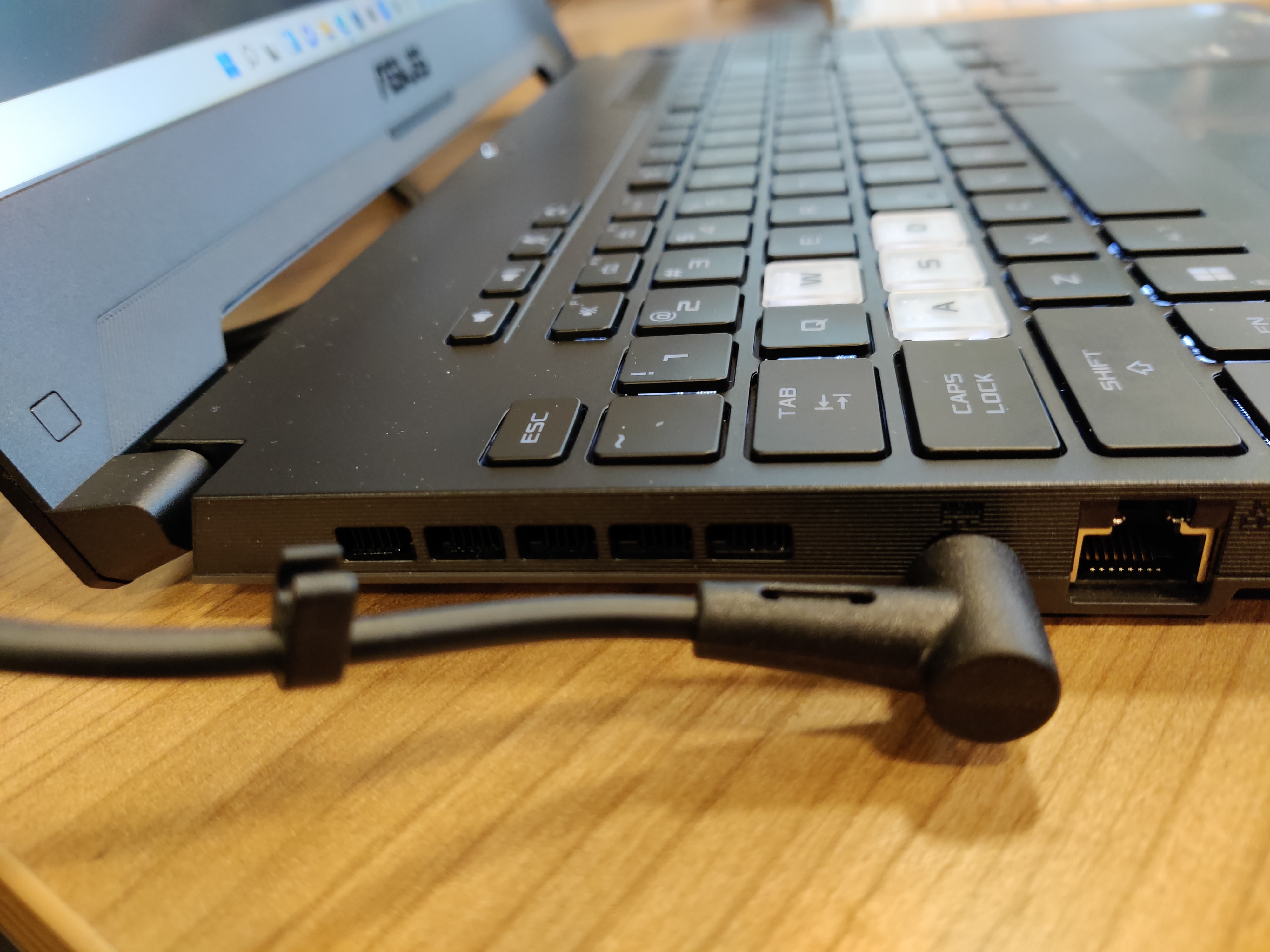
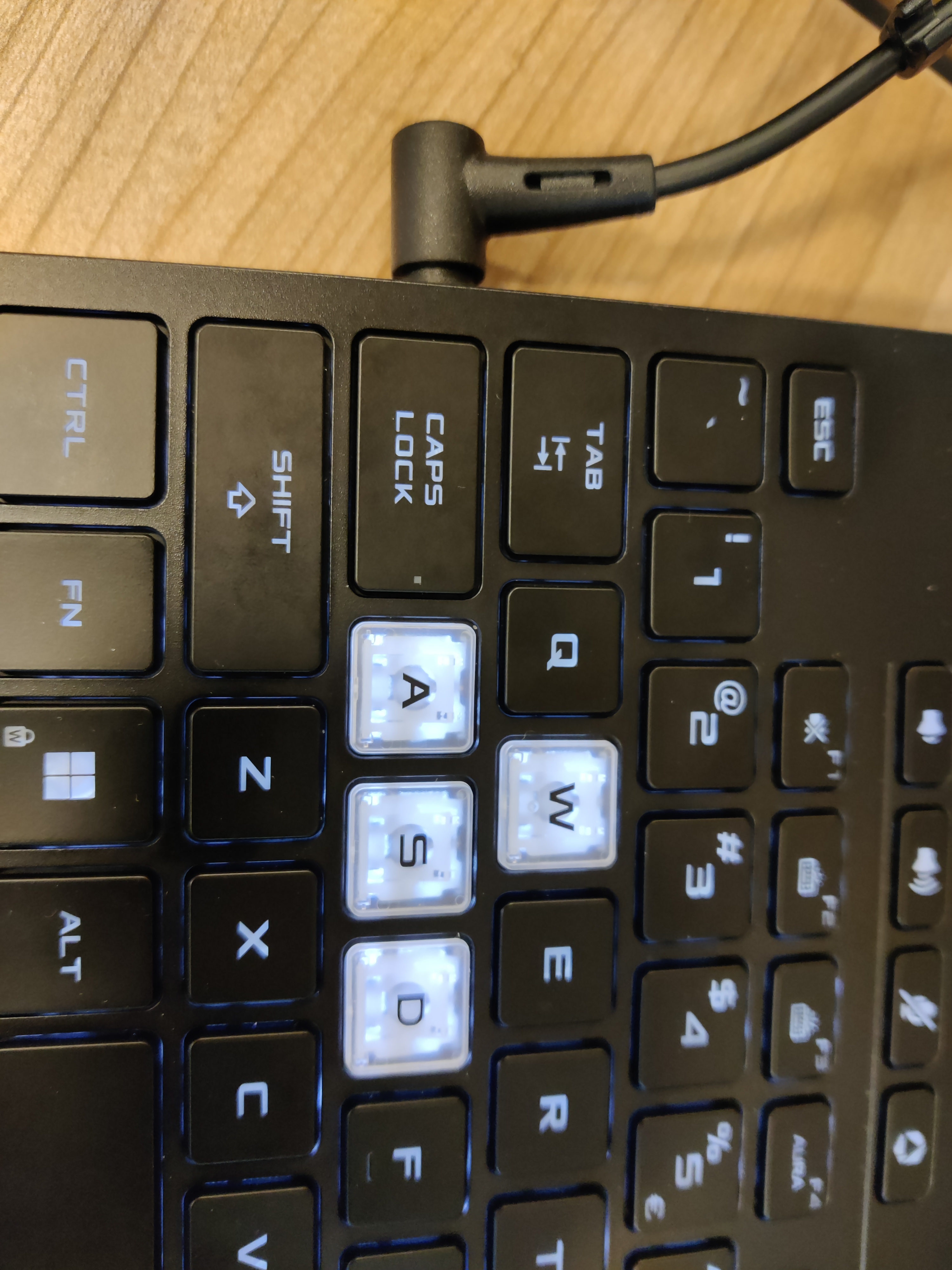
A lot of tech hardware even vaguely related to gaming is usually crammed with RGB lighting, which can be a big turn-off for a lot of people if that’s not really your vibe. There’re loads of laptops on the market (including several from ASUS itself) that support RGB, where the edge of the laptop light up in the wonderful colors of unicorn vomit when you boot it up.
So, there’s that. Good news: the design of the ASUS TUF Dash F15 is nice and sleek and simple. The use of clean lines looks very professional, so like we said the laptop won't stand out like a sore thumb in an office environment. RGB is nowhere to be found; the keyboard lights up with subtle white LEDs that help you find the right button during those late-night gaming hours.
Unlike most older gaming laptops (and plenty still on the market today), you don't have to be a bodybuilder to carry this laptop around with you. The laptop only weighs about 2 kg and we were positively surprised by that.
A great detail to add is the white WASD keys on the laptop, which feel slightly different from the rest. The keys themselves are fine for a built-in keyboard on a laptop. If you are really a serious gamer, you'll probably want to switch to an external keyboard. That's not to say you can't get work done on the F15, though because it's a full-scale keyboard with a numpad.
The laptop has two USB-A ports and two USB-C ports, one of which supports Thunderbolt 4. In addition, there is of course an Ethernet port, a charging port, and an HDMI connection. This brings us nicely to a vague design choice that we do not understand. Why would you place almost all of these ports exclusively on the left side of the laptop?
Sure, if you're right-handed and you connect a mouse, it's pretty inconvenient to have all kinds of cables on the right side of your laptop that you have to play around with. But placing all cables on the left side is no better, especially not for any southpaw users. The placement of the Ethernet and the charging port is especially confusing. During gaming, it was common for the already-thick charging cable to get in the way.
There must have been a logical reason to place the majority of the ports on the left, but we wonder aloud if it wouldn't have been smarter to use the back more. The Lenovo Legion Slim 7i, for example, also has the connections all at the back of the laptop, so the cables don't get in the way. It's a minor issue that some users won't take umbrage with, but it's certainly something to consider.
Design score: 4.5/5
ASUS TUF Dash F15 (2022) Screen
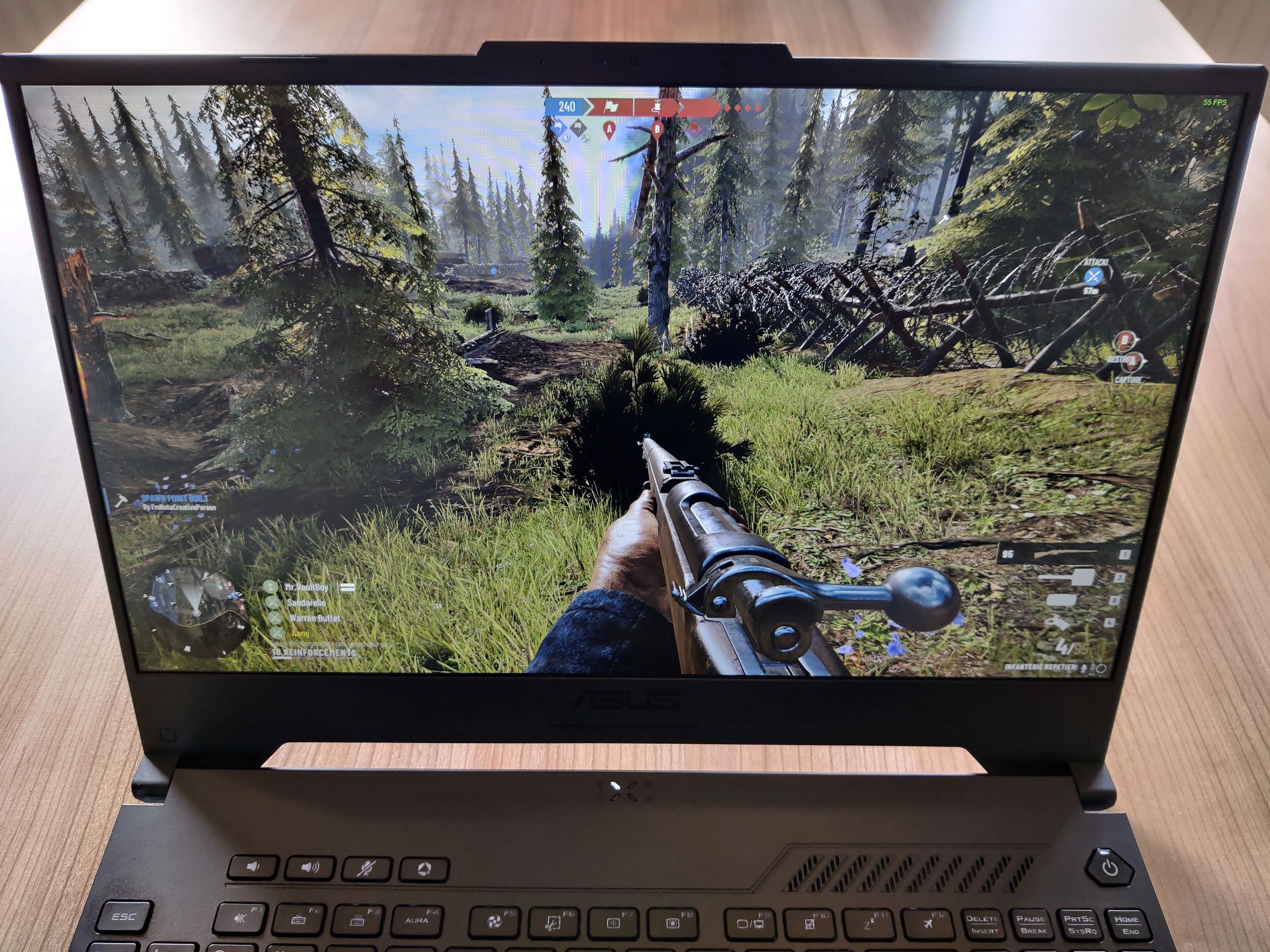

Our configuration of the ASUS TUF Dash F15 features a 15.6-inch full HD IPS panel with a resolution of 1920 x 1080 pixels. The screen is clear and color density is good if not incredible, but if you don't plan to use a second monitor, a 15.6-inch screen can be a bit on the small side for some games.
You probably won't have this problem with most games, but titles that can benefit from a larger screen or a higher resolution - we're thinking of real-time strategy games that can cram a ton of moving units on-screen at once - might not be a great fit for this display.
For this reason, you may prefer the 17.3-inch model or the WQHD model with a resolution of 2560 x 1440 pixels. An extra advantage of the latter model is that it has a refresh rate of 165Hz.
Our configuration has a refresh rate of 144Hz. Fortunately, this is the widely-accepted standard for a gaming monitor in general, so lower wouldn't have been acceptable.
You can play well in direct sunlight, but you will see some glare on the anti-glare screen at certain angles. This isn't really a problem, in our opinion; if you're going to take your expensive gaming laptop to a public park or play it directly under a strong fluorescent lamp, then you have the wrong priorities.
Display score: 4/5
ASUS TUF Dash F15 (2022) Performance
The Asus TUF Dash F15 configuration we tested was equipped with an Intel Core i7-12650H, Nvidia GeForce RTX 3060 Laptop, 16GB DDR5 RAM, and a 1TB SSD.
In addition to the discrete graphics card, the laptop also has an integrated Intel GPU, the Intel Iris Xe Graphics 64EUs. The idea behind this is that the Intel iGPU takes care of everyday graphics tasks and that the RTX 3060 is used during gaming or when you perform an intensive task such as video editing. In practice, this works perfectly except for the software side, which we’ll get into.
It’s pretty obvious when the laptop switches to the RTX 3060 because you can hear it from the fans. This isn't a problem, as we wouldn't expect a fairly compact laptop to have the most premium cooling. For a mouse-quiet gaming experience, you should still choose a desktop where there is space to cool the device properly. There is a ventilation opening at the top right of the keyboard and in practice, we found that the top row of keys can get quite hot after a long gaming session.
We clocked a maximum internal temperature of 95 degrees, and the idea of frying an egg atop the chassis came to mind, but luckily the temperature dropped fairly quickly once we were out of the game. It's worth bearing in mind that many gaming laptops - especially thin-and-light ones - have similar issues, so this isn't a problem unique to the Dash F15.
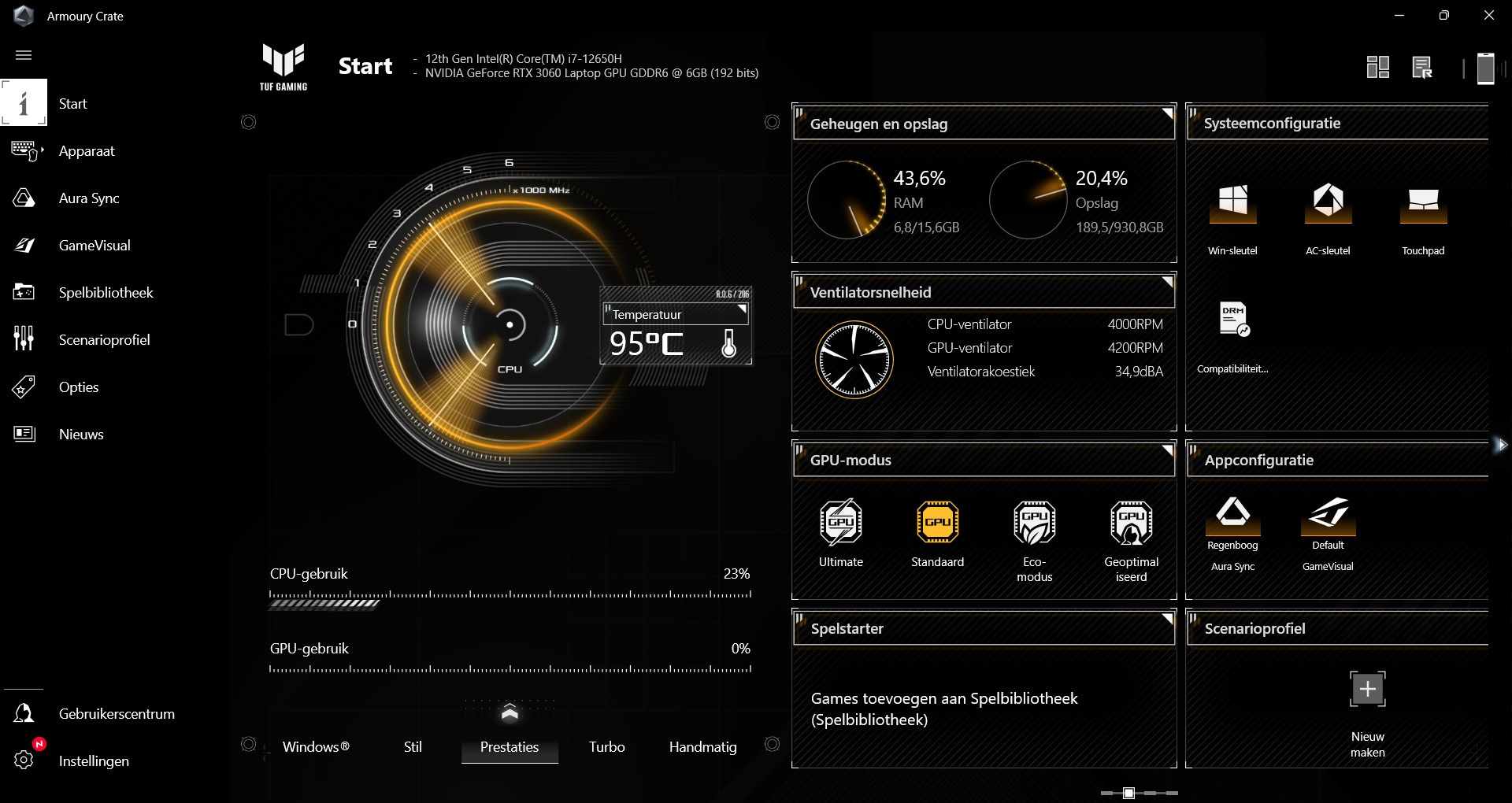
The Nvidia RTX 3060 had no problems with most of the games we played. The new World War I shooter Isonzo ran fantastically on medium settings, and even on the highest settings, we managed a respectable 40/50 fps. This is not much of course, but we are talking about a game in which you play with dozens of people at the same time where the bombs hit around you, and you often have to walk through clouds of mustard gas. No one likes that, and those are all things that are hell for a GPU.
Most other AAA titles also ran great including Wolfenstein II, Dark Souls 3, Overwatch, and even a classic, Age of Empires II: Definitive Edition. On our game of choice, Counter-Strike: Global Offensive, we consistently hit 200 to 300+ fps on the highest settings. But in general, you play these games on the lowest settings if you want to be a bit competitive, and we noticed something curious about that. The combat at long range was very fluid, but we noticed that the fps dipped when making abrupt movements from left to the right. After this discovery, we paid more attention, and if we did an air strafe (you jump, and move your character from left to right, or vice versa) the fps would drop by as much as 80 frames.
The framerate recovered very quickly after such antics, but we played at the lowest possible settings due to the competitive nature of the game, and frame drops are not welcome. Especially since ASUS also mentions 'smooth performance for esports' in their marketing, this could be a stumbling block.
If you game without a headset, you could choose a worse laptop. With the two Dolby Atmos-powered speakers, you get a full-bodied, clear sound. Still, we recommend always using a headset if you want to get the most out of a game's audio.
Performance: 4/5
ASUS TUF Dash F15 (2022) Battery
Gaming laptops have never been known for their impressive batteries, nor should you expect Chromebook-like results from the TUF Dash F15. With a single charge we could go through an average of four hours, but we're not talking about gaming. These are less intensive work tasks such as writing, watching videos, meetings, writing, and maybe a short game of deathmatch in your break. However, you won't easily get through the day without a charger, so make sure you put the charging block in your bag before you leave home.
With the supplied charger, you can fully charge the laptop in about an hour. You can also use the Thunderbolt 4 port to charge your laptop. This makes it possible to provide your laptop with extra power via specialized power banks so that you can still send your work report - or get the next bonfire in Dark Souls - before you lose all your progress.
Battery score: 3.5/5
ASUS TUF Dash F15 (2022) software
We don't know why, but in the first week we tested the ASUS TUF Dash F15, the gaming laptop didn't feel like working. It started when we wanted to play Counter-Strike: Global Offensive at a different resolution than native, namely 4:3 stretched. Perhaps a separate choice for a resolution, but in the world of esports (and especially first-person shooters), it is very common to play on this. The in-game models then appear slightly wider and less zoomed out, making it feel easier to get difficult shots.
In the Counter-Strike: Global Offensive options we selected the 4:3 resolution and the laptop decided it had had enough and the screen went completely black. The screen didn't turn off, as we still heard the typical click when we hovered over the options. After we force-quit the game, it kept booting up with a black screen until we forced the game in the launch options to use the 16:9 aspect ratio.
The suspicion is that the scaling didn't work, but to our surprise, we couldn't find that option anywhere. Normally that option is in the Nvidia control panel, but only the 3D settings were visible. Due to the two graphics cards in the laptop, one for everyday use and the RTX 3060 for intensive tasks, the options are divided, and the Intel options for the standard graphics card show no options to adjust the resolution of the screen.
After some research on the internet, it turned out that it should be possible to 'activate' these options if you disable the internal graphics card in the BIOS settings, but that does not seem to us to be the intention.
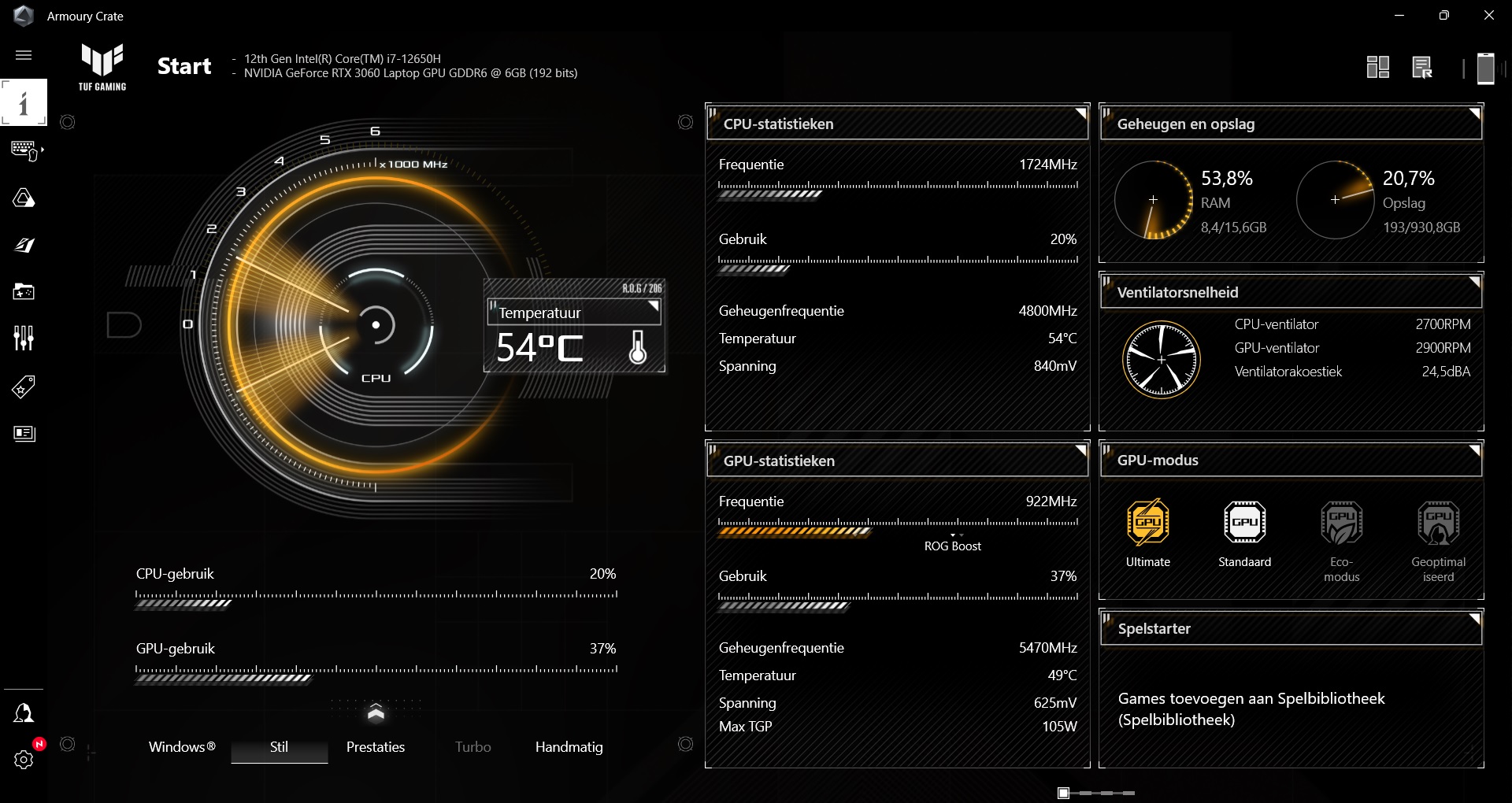
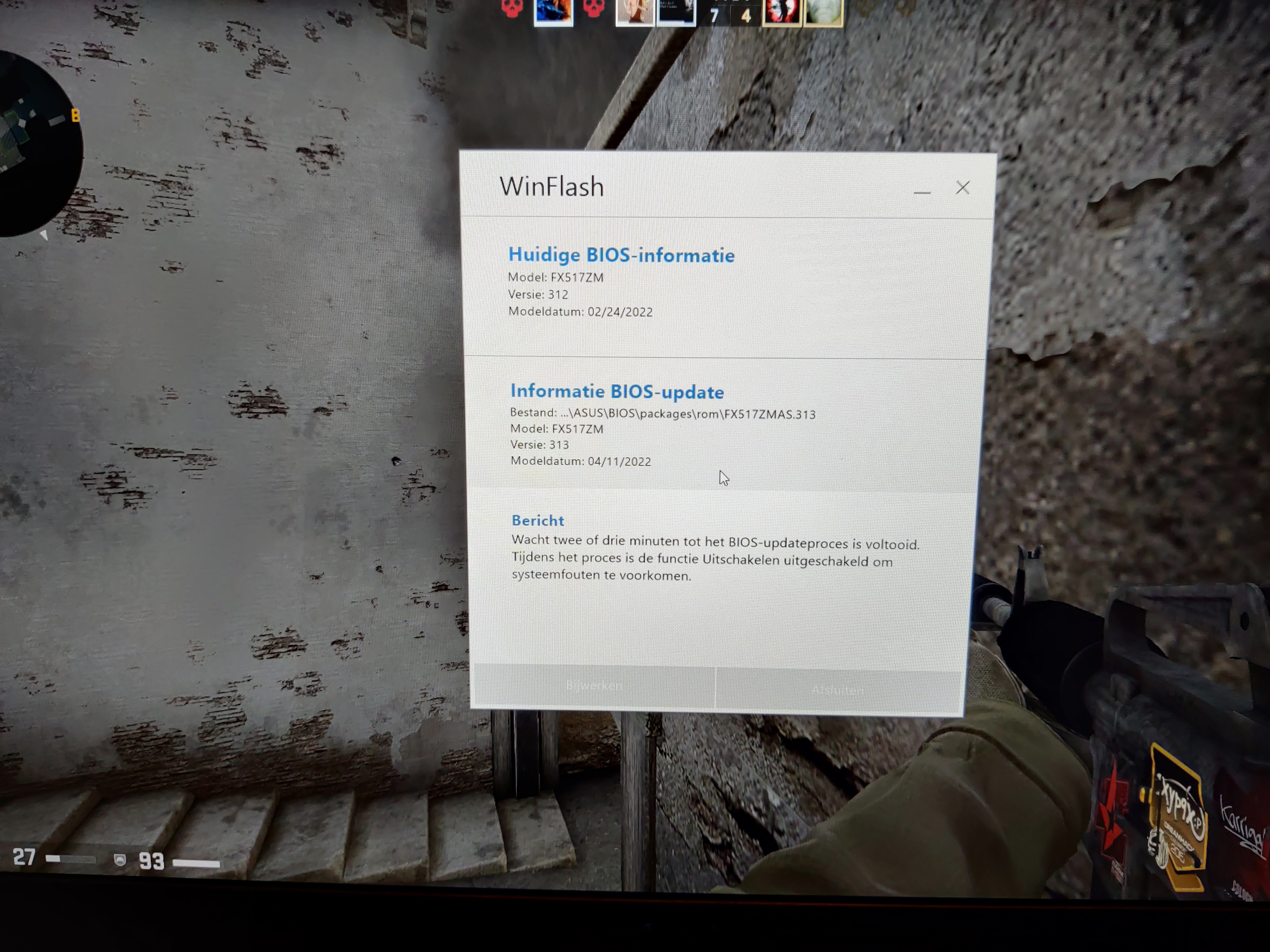
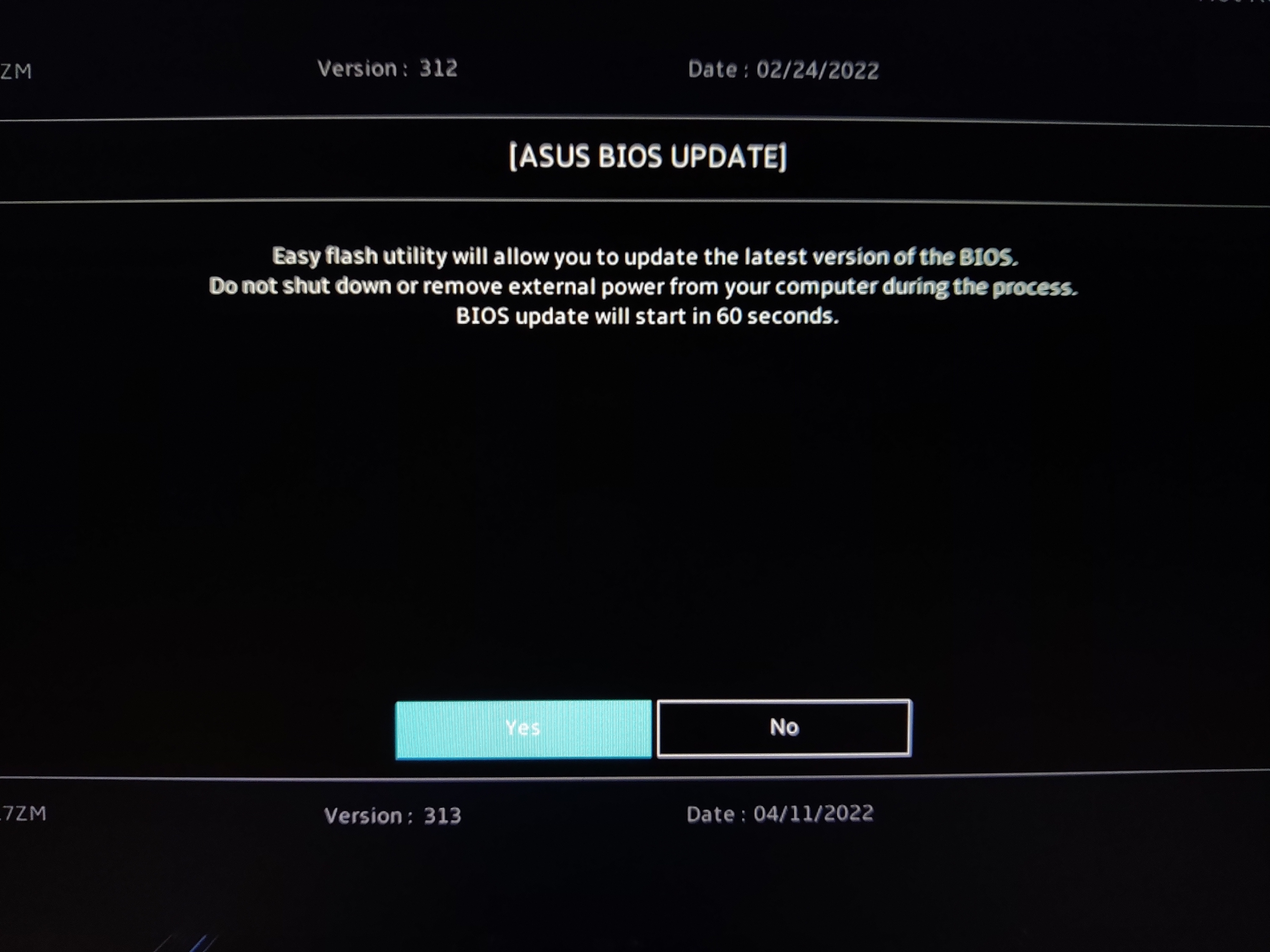
Speaking of the BIOS, the TUF Dash F15 attempted to update the BIOS up to three times. The first time was during a game of ranked Counter-Strike where we were kicked out of the game and had no option to decline the 'request'. The laptop crashed completely during the update, so we had to abort the game for nothing. The second time was again during a game of Counter-Strike, and again we had no option to postpone the update. A gaming laptop should never, ever need an update that can't be postponed. Imagine being a professional player in the middle of a qualifier match and your laptop decides to update your BIOS!
The third time was a few days later. We haven't had any major problems since then, so we'll just call it "boot problems." Apart from these things, ASUS has strong software. With the help of the Armory Crate tool, you immediately have access to all useful statistics about your laptop. This way you can read the temperature, how much RAM and storage is used, view the fan speeds and you can switch GPU modes. For example, it is possible to set the GPU to your specifications, with the Ultimate mode using the maximum processing power of the graphics card to make your games run as beautifully and quickly as possible. Armory Crate is a fantastic tool that some people can poke around in for hours.
Software score: 3.5/5
Scorecard
| Category | Remark | Score |
|---|---|---|
| Design | Sleek, professional design that is comfortable in a home setup or at the office. | 4.5/5 |
| Screen | Clear screen, could be a bit bigger. | 4/5 |
| Performance | Games run smoothly, but occasionally fps drops in fast-paced titles. | 4/5 |
| Battery | We don't recommend intensive gaming without mains power, but the battery is more than enough for most other things. | 3.5/5 |
| Software | Armory Crate is great, but the startup issues and invisible settings were annoying. | 3.5/5 |
| Price | There are worse deals to be found, even if last year's model is arguably better value. | 3.5/5 |
| Overall | A strong showing with a few drawbacks, the Asus TUF Dash F15 is still a sound choice of thin-and-light gaming laptop. | 3.83/5 |
Should you buy the ASUS TUF Dash F15 (2022)
Buy if...
You're looking for a laptop for work and gaming
If you're looking for the perfect hybrid laptop for work and gaming, the ASUS TUF Dash F15 has you covered.
You want to play AAA games without a busy set-up
The keyboard of the TUF Dash F15 is fine for gaming over a longer period of time, connect a mouse and you have a surprisingly strong gaming setup.
Don't buy if...
You're on a budget
There are of course more expensive gaming laptops, but let's be honest: this laptop is not the cheapest. You could probably get more for your money with a different device.
You want to become a professional gamer
The laptop runs great, and most games run smoothly, but for those with aspirations to go professional, a fixed gaming desktop is a better choice.

Jouri heeft een passie voor esports en de laatste technische snufjes. Hij is ook de trotse eigenaar van een Garmin Instinct Crossover, die hij gebruikt om zijn workouts in de sportschool, bergwandelingen en avonturen in moshpits te tracken.
- Muskaan SaxenaComputing Staff Writer
- Christian GuytonEditor, Computing
